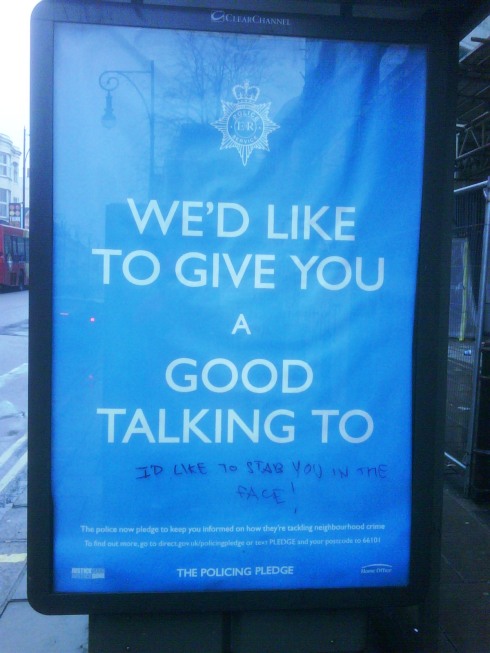You are currently browsing the category archive for the ‘advertising’ category.
Category Archive
Social persuasion FAIL?
June 8, 2009 in advertising, Spotlight on..., Theory, warning: long post! | Tags: advertising, COI, graffiti, media, social | Leave a comment
Along with most of the media agencies in London, my colleagues and I are already mentally preparing for this year’s main event- the mega-pitch happening sometime in autumn featuring the UK’s “number one advertiser”, the COI.
Even though I’ve yet to start any proper work on it, something has already started to mentally niggle me- and it’s to do with the efficacy of social advertising.
Now I (and I think most planners) LOVE working with COI briefs. This is for a number of different reasons; not only do they offer a chance to flex some planning muscles we don’t get to use that often (hard to reach audiences, meaty messaging challenges etc), they also provide a subtle sort of catharsis… we get to feel like we might be using our advertising powers for good rather than for evil.
I think that deep down, most of the time we feel like Nick O’ Teen rather than Superman, and when we work on COI campaigns, we get to change sides.
This can create a pretty heady sense of self-congratulation, and I’m starting to wonder whether the giddiness that results from working on something that actually matters might be blinding us to something more fundamental- that social campaigns are often very poorly served by advertising.
Of course there are some great individual pieces of creative (the DfT’s cameraphone ad by Leo Burnett is a standout example) and some pretty cool media stunts- like this from Ogilvy & Mather Mumbai:

Using public swimming pools to physically manifest a vision of a globally-warmed future is a pretty nice idea. But is it anything other than a nice idea?
I’m wondering whether we celebrate the cleverness of these ideas because of their appropriateness to the task at hand or because we like the fact that they are cleverer, more daring than the average piece of messaging. The fact that they’re good in both a qualitative sense and a moral sense makes them doubly worth celebrating (and probably explains why they do so well at events like Cannes).
Whilst this isn’t necessarily a bad thing, it is worth remembering that for every one of these exceptional pieces of insight or execution, there is mountain of mundanity within the category – for example:

I don’t know what you think about this particular ad (and who knows, it may be working) but for me, the fact that it’s for a good cause doesn’t excuse the essential lameness of the idea. The camp-sinister imagery lurking within the typical smiley-happy veneer of ‘lifestyle’ advertising isn’t shocking or unsettling; it’s as expected and as dismiss-able as the glossy ads it apes.
Is there a problem here? Most people already know the message content of any given social campaign and are unlikely to disagree with its core premise – don’t drink too much, stop look and listen, giving blood saves lives, smoking is bad for you and so on and so on. What agencies seem to do by default is attempt to find ever more ‘creative’ ways of dramatising the stuff we already know. However diverting the stunt, however carefully orchestrated the shock- does any of it actually address the cognitive dissonance that’s at the heart of these issues?
Even celebrated work like TfL’s ‘spot the rollerskating bear’ viral fits the same template – it’s an old dog with a new trick. If the our objective is to change behaviour, why is so much money being spent on telling people stuff they already agree with? The issue that we need to address won’t be solved by dramatising various tragic things that can happen to us if we don’t do what we’re supposed to- the problem is that people agree with this stuff but still don’t act in accordance with what they believe.
This is why advertising might be a bad choice for social campaigns per-se; advertising rarely makes people think, it more often absolves them from thinking. Advertising works (in the main) by fulfilling expectations rather than confounding them. The advertiser’s toolbox is stuffed with tropes. We work within an accepted vocabulary that allows us to make reference, analogy, allusion and the occasional sleight of hand- all techniques that rely on the audience’s media literacy, their expectations of how advertising behaves.
So what happens when the art of creating comfortable fallacy collides with the need to convey genuine and meaningful intent?
Quite often you get weird and unhappy marriages, like this:

Even without the ‘UGC’ adorning the site, this ad connotes all the wrong things for me.
Conversational wit is not something people generally associate with police officers, and it’s employment here creates a strange sense of remoteness – the copy-writing makes it clear that you’re dealing with advertising, not any kind of direct consumer promise. Given that, the choice of words actually does seem inappropriate, particularly when combined with a medium that excels in creating a direct, physical presence you have to walk around. It’s supposed to be friendly, an avuncular invitation to you to share in a joke, but instead it’s in your face, encouraging you to laugh at something that’s not funny in a vaguely threatening way. Bizarre.
Moreover, this communication exists in a medium with no obvious means of interaction. The public can text in to a shortcode, but are fundamentally unable to see themselves represented in this campaign, to feel part of it, unless they take the very direct route of actually writing on it- of vandalising it. Promoting ‘talking’ with a static poster. Hmmm.
Social advertising like this is weird. It’s like the notes that appear on appliances and doors in a shared flat that become the site of contrasting claims.

People leaving announcements in communal spaces aren’t actually having a conversation with someone, they’re playing out a performance in public- a performance that sacrifices the efficiency of actually dealing with the issue for the appearance of dealing with it. Advertising of this type dramatises a relationship whilst simultaneously avoiding the kids of actual, embodied behaviours that are important in relationships – like listening, being respectful, finding time to talk to someone on their terms and so on.
There could be all sorts of reasons why someone felt compelled to write “I’d like to stab you in the face” on this ad – but I think a contributing factor may well be that people actually resent being communicated with in this way when its about stuff that matters. Behavioural stuff. Moral stuff. Responsibility stuff. The double-whammy of a high-handed tone and the sense that a dialogue is being avoided rather then sought tends to annoy – exactly as it does on the fridge door of a shared flat. Often the most immediate urge is to reply, right there, on the annoying note itself. Otherwise, as I’m sure anyone who’s ever left a ‘please clean this’ post-it can attest, a note is much easier to ignore than a conversation.
Obviously the average social campaign is slightly more sophisticated than a note left on a fridge- good insight, inspiring artwork, copy-writing, layout and such can achieve much. Also, there are many iconic examples of social advertising that have left their mark on our shared culture. However, despite (perhaps because of) their well-meaningness, the majority of social ads seem to me to occupy the same region of attention bandwidth as high-handed notes- somewhere between ignorable and annoying. Having flicked through a few pages of ads over at Osocio, it seems to me that a lot of NGOs could have spent their money more effectively by avoiding advertising altogether.
I snapped this in our office kitchen the other day – and I think it’s a pretty apt summation of the effectiveness of this approach. Scroll down for the punchline…

The nameless one offers ‘many thanks’ which are meaningless in motivational terms.
‘Helping to keep the kitchen tidy’ is clearly not enough of a shared or meaningful objective – and given the proximity of the crime to the warning, one almost gets the suspicion that the offenders actually enjoy the failure to comply.
No-ones behaviour is being impacted positively here.
It seems we need more creative ways of thinking about the context of the action and the use of incentives, disincentives and social norming pressures to make the right course of action seem more desirable, or in fact seem the natural thing to do, so we don’t even think about it. Advertising should not be our default.
By way of contrast to the swimming pool stunt above, I really liked this project from Bristol, mostly because of the context in which it’s encountered. To see the Mumbai ad, you have to be going swimming at a pool anyway (which in Mumbai probably puts you in a minority I guess), or be a reader of advertising blogs. To understand the threat of global warming in Bristol, you just walk around town as usual, but you see the familiar made strange as your own personal landmarks and waypoints start to tell you a new and disturbing tale.
In an instant, your perspective is altered.

This isn’t advertising delivering a message to behave better, this is a behavioural intervention. Perhaps tellingly, it came from the arts sector rather than the commercial.
